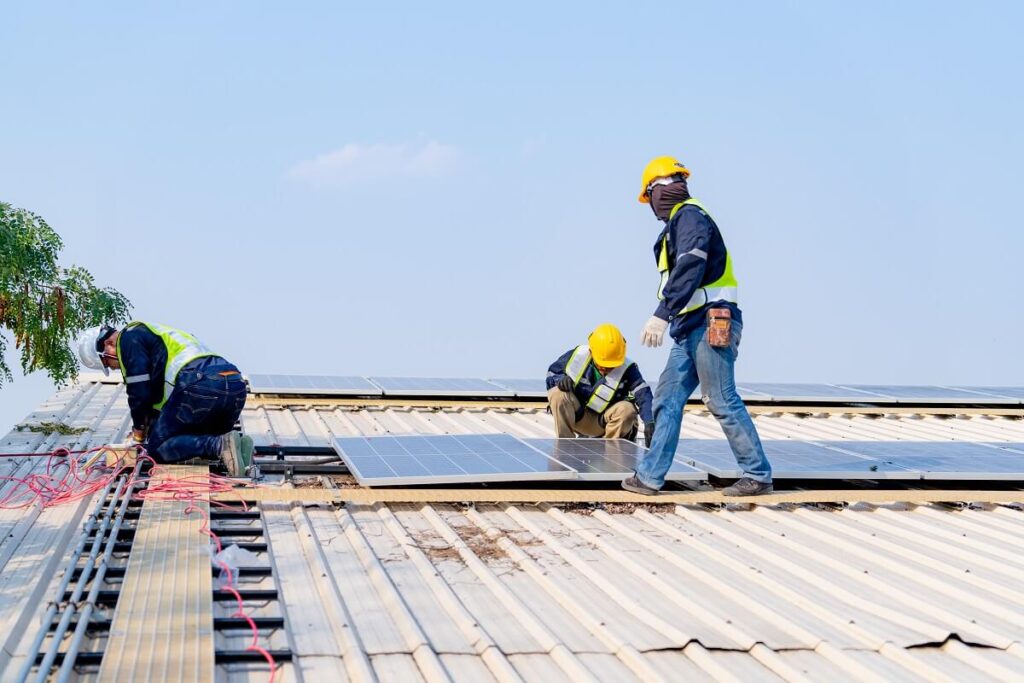It may surprise you to learn that roof repair or replacement will benefit everything from your bank account to your family’s health. Here are some of the most popular benefits of efficient roofing materials, and we’ll follow up with some of the best materials to consider if you are planning to put on an energy-conscious roof.
Energy Cost Reduction
Energy-efficient roof replacement helps reduce energy consumption by reflecting solar heat away from the building, which means less air conditioning is needed to keep the building cool, and thus lower energy bills. Heat rises, and that can cause a substantial increase in your heating bills if your roof is old and not performing as well as it should be. Energy reduction alone probably won’t recoup your roofing investment, but it will make the cost more appealing.
Roof Longevity
More efficient roofs also tend to have a longer life expectancy than– for example– asphalt shingles. Modern roofing materials are engineered to have less of an ecological impact while delivering the most home protection. Energy-efficient roofs are designed to last longer than traditional roofs due to their improved insulation properties, which protect the roofing material from extreme temperatures and weather conditions.
Sustainably Greener
Sustainability comes from a couple of different aspects of high-efficiency roofs. On the one side, extended roof longevity means fewer natural resources have to be used to achieve the same protection. But efficiency means environmental advantages in a practical sense as well. By reducing the amount of energy used to cool a building, energy-efficient roofs reduce the carbon footprint of the building, leading to a more sustainable environment.
Personal Comfort
Together with your siding, your roof completes the external seal of your home. Harsh exterior conditions are held at bay, extreme temperature fluctuations are kept in check, and even the heaviest rainfall is unable to penetrate to the home’s interior. Energy-efficient roofs help maintain a comfortable indoor temperature by reducing heat transfer from the outside, leading to improved comfort levels for building occupants
Roof Maintenance
As older roofs begin to lose their efficiency, the amount of regular maintenance required to keep the roof in decent condition increases. At first, you have to clean gutters and replace a shingle now and again, but you will see more and more torn shingles, fasteners that have pulled loose, and other signs of age and wear. Energy-efficient roofs require less maintenance than traditional roofs due to their improved durability and resistance to weather and temperature fluctuations.
Boost Home Value
Having an energy-efficient roof is a talking point when you get ready to sell the house. Today’s buyers are more interested in homes that are compliant with modern efficiency guidelines. But there are more value enhancements as well. Installing an energy-efficient roof can increase the value of a property by reducing energy costs, improving comfort levels, and increasing the lifespan of the roof.
Code Compliance
Energy efficiency is required in many municipalities across the country as they take steps to face the climate challenges of tomorrow. Many building codes require energy-efficient roofing materials, so installing an energy-efficient roof can ensure compliance with these codes.
Potential Rebates and Credits
Choosing a more environmentally efficient roof comes with perks. From municipal utilities to government agencies, you may find rebates and tax credits to property owners who install energy-efficient roofs, which can help offset the cost of installation.
A Cleaner Future
The less efficient your roof, the harder your HVAC unit will have to work, and that generates greenhouse gases in the atmosphere. Even closer to home, interior allergens and pollutants collect in your ductwork, and increased unit activity means more potentially harmful contaminants in your breathing space.
Building Safety
Roof design has improved to meet environmental changes over the years, and your older roof may not be as capable of protecting your home as a new one would be. Energy-efficient roofs are often designed to be fire-resistant and to prevent the growth of mold and mildew, improving the safety of the building and its occupants.
Energy-Efficient Roofing Materials
Installing a more efficient roof does not mean getting stuck with only a choice or two. High-efficiency roofs are available in materials ranging from asphalt to vinyl, including these:
- Metal – Metal roofs are highly energy efficient as they reflect heat from the sun, reducing the amount of heat absorbed into the home. They can also be coated with reflective materials to further increase their energy efficiency
- Clay and Concrete – Clay and concrete tiles are durable and provide excellent insulation. They can help regulate the temperature in your home and reduce your energy bills.
- Asphalt Shingles – While not as energy efficient as metal or tile roofs, asphalt shingles can still be a good option. They are available with reflective coatings that can help reduce the amount of heat absorbed into the home.
- Solar Tiles – Solar tiles are an innovative option that can generate electricity from the sun. They are installed just like regular roof tiles but contain photovoltaic cells that convert sunlight into energy.
Roof Style Impacts
The style of your roof is also a factor in the overall efficiency. Choosing the right roof style can play a significant role in improving a building’s energy efficiency and reducing its carbon footprint. Some things that should be considered when planning a new roof include:
- Insulation – The type of roof and its shape can affect the amount of insulation that can be added to it. A pitched roof, for example, may allow for more insulation, which can improve the energy efficiency of a building.
- Ventilation – The design of a roof can impact the amount of ventilation that can be incorporated into it. Good ventilation can help regulate the temperature of a building, reducing the need for heating or cooling.
- Heat gain – The color and material of a roof can affect how much heat it absorbs. Lighter-colored roofs reflect more sunlight, reducing the amount of heat that enters the building.
- Going Solar – Certain roof styles may be better suited for the installation of solar panels, which can reduce a building’s reliance on traditional sources of energy.
Peak Roofing & Exteriors
If you’re looking for an honest and experienced team that can handle your residential or commercial roofing project in Northwest Arkansas, Northeast Louisiana, or West Texas, look no further. Peak Roofing & Exteriors can take care of your home or business with quality and integrity. Contact us today and book your FREE inspection!

